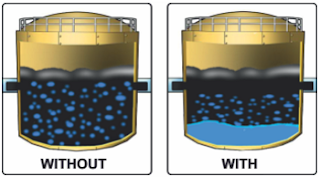Much of the oil produced worldwide is accompanied by water
in an emulsion that requires treating. Even in those fields where there is
essentially no initial water production. Technical Data used in the field
explained in petroleum courses in Islamabad.
water cuts may increase in time to the point where it is necessary to treat the
emulsion. Water content of the untreated oil may vary from a fraction of I % to
over 90%. To prevent increased transportation costs, water treatment and
disposal costs, and deterioration of equipment, purchasers of crude oil limit
the basic sediment and water (BSSCW) content of the oil they purchase. Limits
vary depending on local conditions, practices. and contractual agreements and
typically range from 0.2 to 3.0%. BY&W is usually predominantly water but
may contain solids.
The solids contained in the BS&W come from the producing
formation and consist of sand. silt, mud, scale. And precipitates of dissolved
solids. These troublesome solids vary widely from producing field to field.
zone to zone, and well to well.
Purchasers may also limit the salt content of the oil. Removing
water from the stream decreases the salt content. Salt content along with
BS&W are the two important crude purchasing requirements. Some more details
of petroleum courses in Islamabad are as under.
An emulsion is a heterogeneous liquid system consisting of
two immiscible liquids with one of the liquids intimately dispersed in the form
of droplets in the second liquid. An emulsion is distinguished from a simple
dispersion of one liquid in another by the fact that, in an emulsion, the
probability of coalescence of droplets on contact with one another is greatly
reduced because of the presence of an emulsifier, which inhibits coalescence.
Such inhibition is not present in a dispersion.
The stability of the emulsion is controlled by the type and
amount of surface-active agents and/or finely divided solids. which commonly
act as emulsifying agents or emulsifiers. As shown in Fig. 19.1, these
emulsifying agents form interfacial films around the droplets of the dispersed
phase and create a barrier that slows down or prevents coalescence of the
droplets.
The matrix of an emulsion is called the external or
continuous phase. The portion of the emulsion that is in the form of small
droplets is called the internal, dispersed, or discontinuous phase. The
emulsions considered in this chapter consist of crude oil and water or brine
produced with it. TSK Training for Skills and Knowledge is the best institute
in Rawalpindi Islamabad for Pakistani Students who wants to join petroleum courses in Rawalpindi.

No comments:
Post a Comment